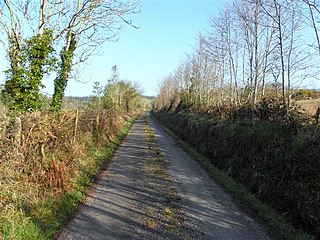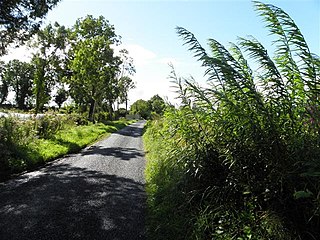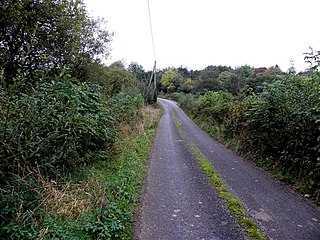Griffith's Valuation was a boundary and land valuation survey of Ireland completed in 1868.

Tydavnet, officially Tedavnet , is a village in northern County Monaghan, Ireland, and also the name of the townland and civil parish in which the village sits. Both the Church of Ireland and Catholic church have Tydavnet named as a parish and in both cases, the geographical area is almost identical. The village is located on the R186 regional road.

Scotstown is a village in the townland of Bough in north County Monaghan, Ireland. Scotstown is located in the parish of Tydavnet, along the Monaghan Blackwater, Scotstown being the village closest to the river's source. Scotstown is centred in the townland of Bough, but extends into Carrowhatta, Teraverty, Drumdesco and Stracrunnion townlands.
Corblonog is a very small townland in the north of County Monaghan in Ireland. It is 0.2 square kilometres (0.08 sq mi) in area, and lies the east of the townland of Sheskin in the civil parish of Tydavnet.
Knockatallon or Knockatallan is a hamlet and townland in the north of County Monaghan in Ireland, being located in the parish of Tydavnet. The Roman Catholic parish church is located in the village of Tydavnet itself. Knockatallan is located to the west of Sheskin. The Knockatallan name is also used by locals to refer to a larger area including several other townlands such as Knockacullion and Corlat.
Killycarnan is a townland in the north of County Monaghan in Ireland, to the south east of the townland of Sheskin in the parish of Tydavnet.
Magheracloone is a parish in south County Monaghan. Its name comes from the Irish Machaire Cluana which means 'plain of meadow'. A generally hilly parish; its name is derived from its most important place in ancient times; a flat area of land in the townland of Camaghy, on which the sports ground and ancient church of St. Molua were located. The parish covers 12,952 statute acres in area, making it the largest parish in South Monaghan. The parish borders three neighbouring counties; Cavan, Louth and Meath..

Cullyleenan is a townland in the Parish of Tomregan, Barony of Tullyhaw, County Cavan, Ireland.

Milltown is a small village in County Cavan, Ireland. The population as at 2021 was around 100. During a nineteenth century O'Donavan townlands survey of County Cavan it was noted that the Milltown area was traditionally referred to as Bellanaleck, there are no other records with this name. The Archaeological Inventory of County Cavan notes (507) Derrygeeraghan, a raised circular Rath area with two substantial earthen banks and a wide deep fosse dating from earlier medieval times. The present Milltown Electoral Division and catchment area comprises several neighboring townlands within an ancient Barony of Loughtee Lower, County Cavan and Drumlane Civil Parish in County Cavan.
A property tax known as "rates" has been levied in Hong Kong since 1845. The tax applies to all domestic and commercial properties unless exempted, and is based upon the rental value of the property, re-assessed each year. Formerly part of the revenue went to the Urban Council and, from 1986, the Regional Council, but since 2000 the whole amount goes to the Hong Kong Government.

Gubbarudda, formerly Gubberudda is a townland in County Roscommon, Ireland about 4.5 kilometres north-west from the village of Arigna. Gubbarudda is a very rural area composed of 432 acres with only two residences. Much of the northern parts of the townland encompasses Coillte woodlands, while its southern areas are situated on the 'Kilronan Mountain Bog Natural Heritage Area'. The population of Gubbarudda as of 2012 totaled eight people.

Scotstown GAA is a Gaelic football and ladies' football club in Scotstown, County Monaghan, Ireland which represents the parish of Tydavnet.

Killycrin is a townland in the civil parish of Templeport, County Cavan, Ireland. It lies in the Roman Catholic parish of Templeport and barony of Tullyhaw.

Gortmore is a townland in the civil parish of Templeport, County Cavan, Ireland. It lies in the Roman Catholic parish of Templeport and barony of Tullyhaw.

Killywaum is a townland in the civil parish of Templeport, County Cavan, Ireland. It lies in the Roman Catholic parish of Templeport and barony of Tullyhaw.

Corlough is a townland in County Cavan, Ireland. It lies in the Roman Catholic parish of Corlough, and within the civil parish of Templeport in the historical barony of Tullyhaw.

Corrachomera is a townland in the civil parish of Templeport, County Cavan, Ireland. It lies in the Roman Catholic parish of Corlough and barony of Tullyhaw. The local pronunciation is Currach-Humra.

Corratillan is a townland in the civil parish of Templeport, County Cavan, Ireland. It lies in the Roman Catholic parish of Corlough and barony of Tullyhaw.
Derryconnessy is a townland in the civil parish of Templeport, County Cavan, Ireland. It lies in the Roman Catholic parish of Corlough and barony of Tullyhaw.
Drumlaydan is a townland in the civil parish of Templeport, County Cavan, Ireland. It is also called Bonebrook locally. It lies in the Roman Catholic parish of Corlough and barony of Tullyhaw.














